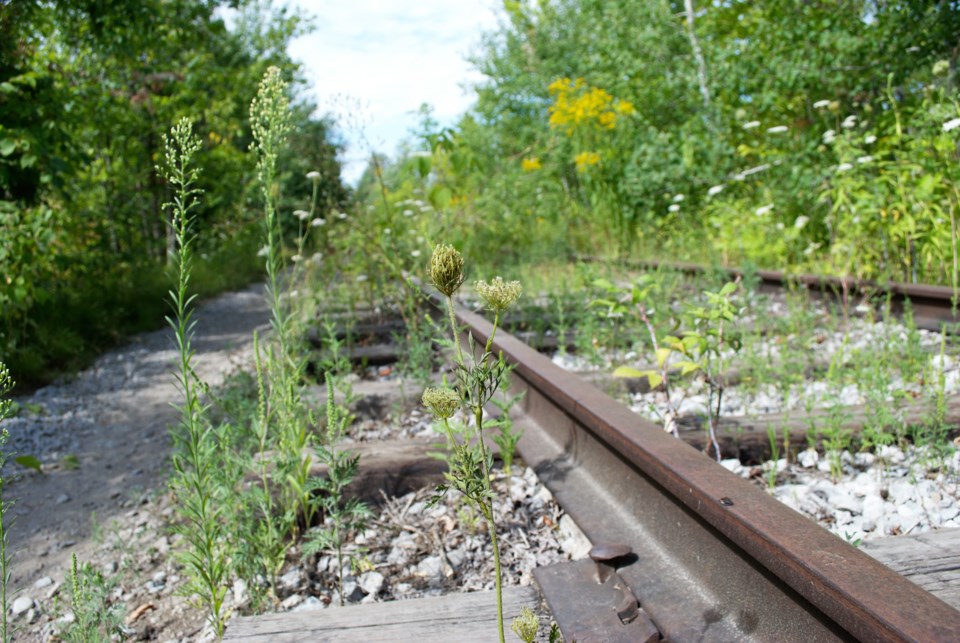While COVID-19 may have temporarily derailed the Barrie-Collingwood Rail Trail project, coming out of the pandemic the County of Simcoe is going full steam ahead to get the project back on track.
The Barrie-Collingwood Rail Trail project would see the County of Simcoe-owned portion of the rail line converted into a multi-use trail. First proposed in 2019, the timeline for the project was put on hold due to the pandemic, but now the county is ramping up again to put out a request for proposals for an environmental assessment and detailed design.
Lindsay Lyall, a former member of Collingwood’s Trails Committee, now called the Trails and Active Transportation Advisory Committee, thinks converting the Barrie-Collingwood Rail Line into an active transportation trail would be an excellent use of the existing corridor.
He points to the well-groomed trail that runs parallel to the track between Collingwood and Stayner, however beyond that travelling south east, he sees an opportunity.
“Beyond that, there’s a real bottleneck,” said Lyall. “I’m seeing the trees grow up on the trail and nothing’s happening with this proposal to turn it into a trail. Maybe now’s the time to stimulate some interest in it again.”
“I’d love to see the corridor opened up,” he said.
The Barrie-Collingwood Railway runs from Collingwood to Barrie, running through Nottawa, Stayner, New Lowell, Angus and Utopia.
The portion of the railway owned by the County of Simcoe runs for 32 kilometres from Collingwood to the Fifth Line in Angus.
“We did have preliminary designs and an environmental assessment in the budget planned for 2020. Unfortunately, due to the pandemic, our priorities did change so that didn’t get accomplished last year,” said Christian Meile, director of transportation and engineering with the County of Simcoe. “We’re looking to complete that now.”
Meile said the county is closing in on a request for proposals for consultants to complete the environmental assessment and preliminary design of the trail by the end of 2021, or the beginning of 2022. Construction on the trail is planned to start in 2022.
According to the 2020 county budget, $400,000 had been set aside for that purpose, which is still the case. Future costs for the project will be brought forward in future budgets to be approved through County of Simcoe council.
In the preliminary design document presented to county council in 2019, staff recommended pulling out the rails to sell for scrap metal but burying and paving over the rail ties, which would minimize costs.
Cost estimates for the entire project are about $4.7 million. Also proposed as part of the conversion is construction of three staging areas for users to park their vehicles: one in Angus at a cost of $220,500, one in New Lowell at a cost of $201,540 and one in Stayner at a cost of $276,780.
Meile said this week that those cost estimates are still holding strong at this point.
Once the environmental assessment and the detailed design are complete, Meile says the county will then be running public consultation sessions to gather resident input.
“We’d like to be able to do that early next year,” he said.
The county spends roughly $50,000 per year to maintain parts of the trail, however Meile says certain parts of the trail get more maintenance than others.
The portion of the Barrie-Collingwood Railway that runs from Angus to Barrie is currently owned by the City of Barrie. The City of Barrie and the County of Simcoe jointly own the Utopia rail yard. The entire line from Collingwood to Barrie is 52 kilometres.
A market feasibility study was commissioned by the City of Barrie and the County of Simcoe on the future of rail line as a whole. Deloitte completed a report at the end of November 2019 that recommended Barrie look into reducing its responsibility for rail operations over the long term and immediately implement financial improvement measures to reduce the city’s fiscal obligations to the line.
The report said BCRY is costing the city money and the municipality should pursue ways to reduce its fiscal responsibility for the rail. To read more about that report, click here.
While the City of Barrie continues to investigate what they plan to do with their portion and their side of the line continues to operate, Meile says it won’t impact how the county deals with their side, and will be proceeding with the rail conversion.
Looking forward, Meile says he’s optimistic the trail conversion will meet the expectations of the public.
“As with any construction project, there are some unknowns that we face. This trail is pretty straightforward. It’s a popular trail north of Stayner and we know there’s a lot of eagerness,” he said.
- with files from Shawn Gibson



